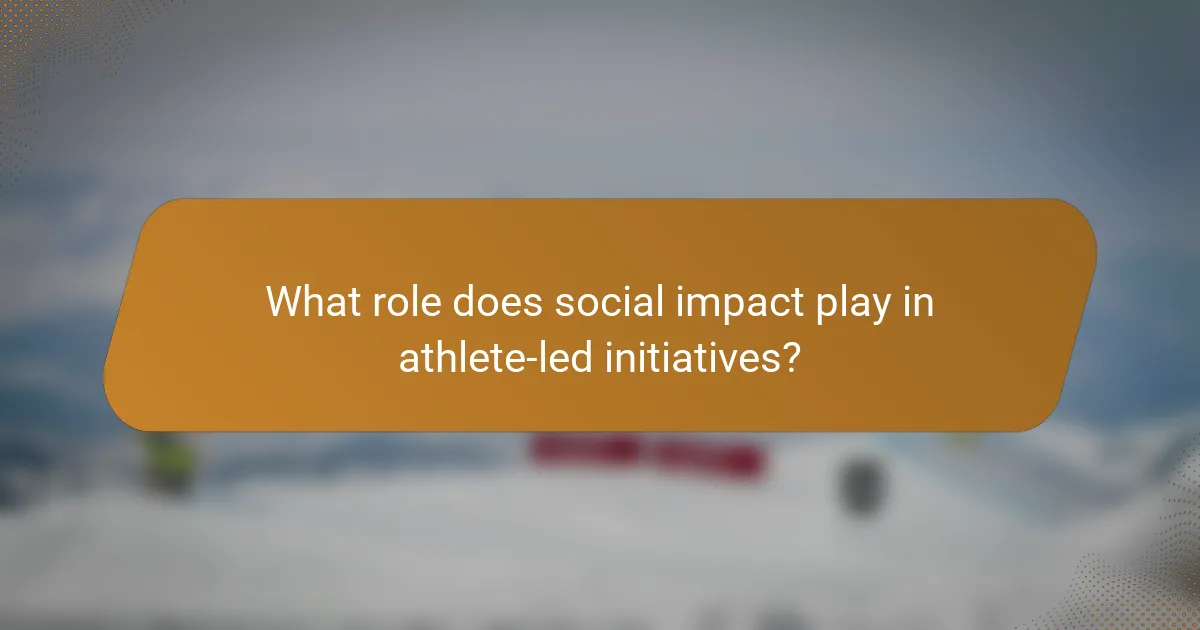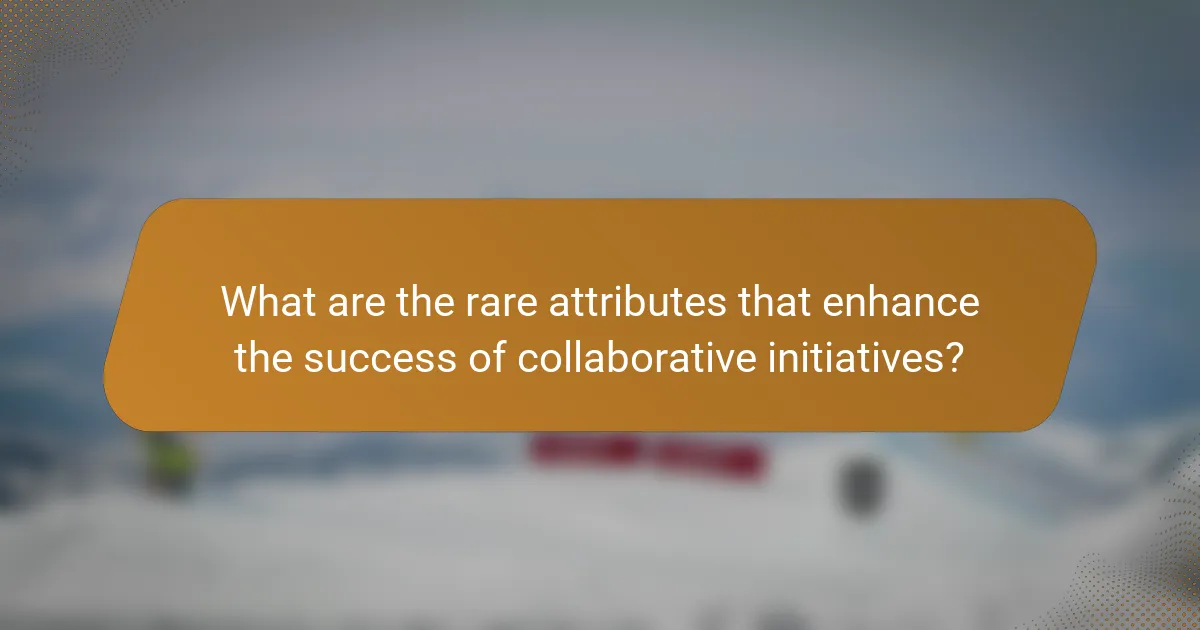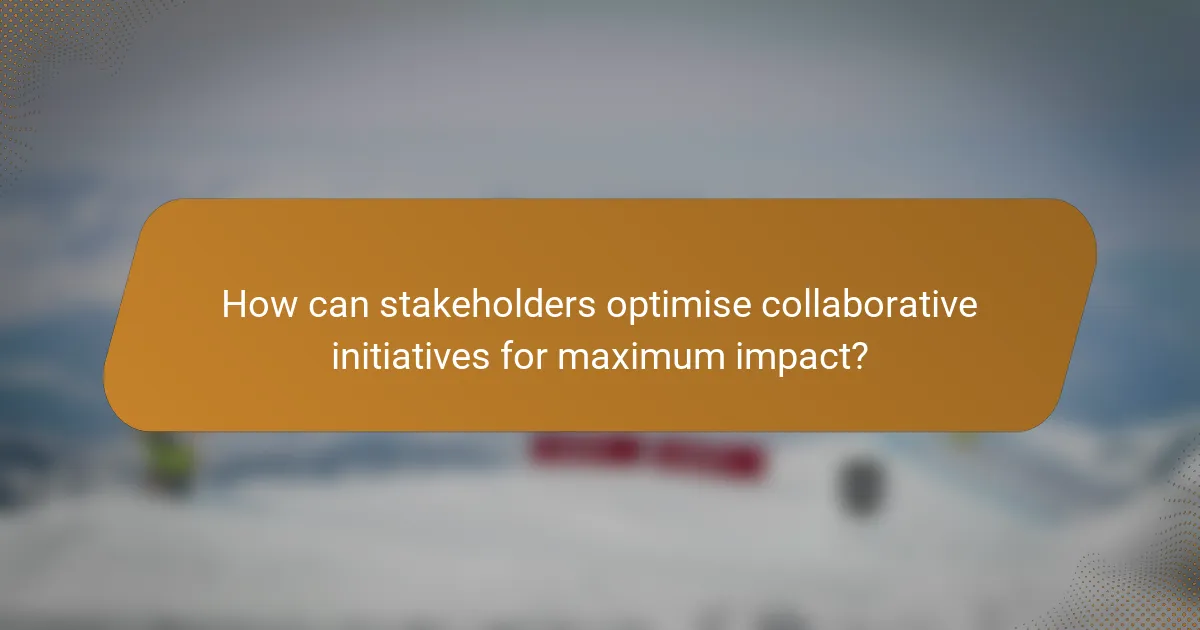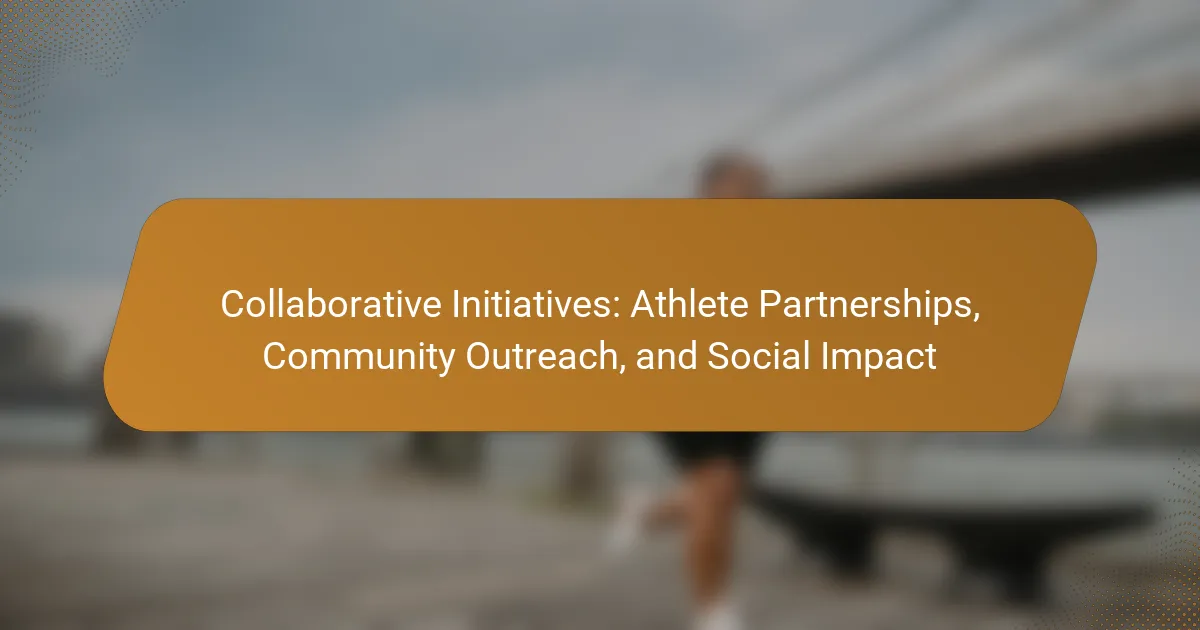Collaborative initiatives involving athlete partnerships can significantly enhance community outreach and drive social impact. These partnerships leverage athletes’ influence to address pressing social issues and promote engagement. Key angles include fostering community engagement, establishing sustainable partnerships, and optimising collaboration with local organisations. By focusing on shared values and innovative strategies, these initiatives create lasting benefits for both athletes and communities.

How do athlete partnerships enhance community outreach initiatives?
Athlete partnerships significantly enhance community outreach initiatives by leveraging their influence and visibility. These collaborations can drive awareness, foster engagement, and generate support for local causes. For example, athletes often participate in events or campaigns that address social issues, thus amplifying their impact. This unique attribute of athletes as role models inspires communities to take action and participate in positive change. As a result, partnerships can lead to increased funding and resources for community programmes, ultimately benefiting those in need.
What are the key benefits of collaboration between athletes and local organisations?
Collaboration between athletes and local organisations enhances community engagement, promotes health initiatives, and fosters social responsibility. These partnerships leverage athletes’ influence to address local issues and inspire positive change.
Athletes can drive awareness for community programmes, attracting participation and resources. Local organisations benefit from the visibility and credibility athletes provide, amplifying their outreach efforts. This synergy creates a powerful platform for social impact, enriching both the athletes’ and communities’ experiences.
For example, initiatives like youth sports clinics not only develop athletic skills but also instil values like teamwork and perseverance. As a result, communities see improved youth engagement and reduced crime rates.
In summary, collaboration between athletes and local organisations leads to mutual benefits, including enhanced community health, increased participation in local programmes, and a strengthened sense of social responsibility.
Which successful athlete partnership models exist in various regions?
Successful athlete partnership models vary globally, focusing on community engagement and social impact. Key models include sponsorship collaborations, athlete-led initiatives, and partnerships with non-profit organisations.
In North America, athletes often partner with brands to promote social causes, leveraging their influence for community outreach. In Europe, many athletes engage in grassroots initiatives, directly impacting local communities. In Asia, partnerships frequently emphasise cultural exchange and youth development, showcasing the athlete’s role in inspiring future generations.
These models demonstrate unique attributes, such as localized focus and the ability to mobilise resources for social change. Each region adapts its approach based on cultural values and community needs, enhancing the effectiveness of athlete partnerships.

What role does social impact play in athlete-led initiatives?
Social impact plays a crucial role in athlete-led initiatives by fostering community engagement and promoting social change. These initiatives often address pressing social issues, leveraging the athletes’ influence to raise awareness and mobilise resources. For instance, athletes partner with local organisations to support education, health, and equality programmes. This collaboration amplifies their reach and effectiveness, creating a lasting positive impact. Furthermore, athlete-led initiatives can inspire fans and communities to participate actively, enhancing social cohesion and promoting collective action for societal betterment.
How do athletes measure the effectiveness of their social impact efforts?
Athletes measure the effectiveness of their social impact efforts through community feedback, engagement metrics, and outcome assessments. They often analyse participation rates in initiatives and track changes in community well-being indicators. Collaborations with local organisations enhance their outreach effectiveness, providing valuable insights into the initiatives’ impact. Surveys and interviews with community members offer qualitative data, revealing personal stories of change and improvement.
What are the challenges faced by athletes in driving social change?
Athletes face several challenges in driving social change, including limited resources, public scrutiny, and systemic barriers. Collaborative initiatives often require significant time and commitment, which can detract from training. Additionally, athletes may encounter resistance from organisations or communities that are hesitant to embrace change. The need for authentic partnerships is crucial, as superficial efforts can undermine credibility. Lastly, navigating the complexities of social issues demands ongoing education and awareness, which can be overwhelming for individuals.

Why is community engagement essential for sustainable athlete partnerships?
Community engagement is essential for sustainable athlete partnerships as it fosters trust, collaboration, and social impact. Engaging with local communities allows athletes to understand their needs and values, creating authentic connections. These partnerships can lead to initiatives that promote health, education, and well-being, benefiting both athletes and communities. Furthermore, successful community outreach amplifies the social responsibility of athletes, enhancing their public image and solidifying long-term support. As a result, sustainable partnerships thrive on mutual respect and shared goals.
What strategies can athletes use to foster community involvement?
Athletes can foster community involvement through collaborative initiatives, partnerships, and outreach programmes. Engaging in local events, mentoring youth, and supporting charitable causes enhances social impact. For example, athletes can organise sports clinics that promote physical activity and teamwork. Collaborating with local organisations amplifies their influence and fosters a sense of belonging. These strategies create a positive feedback loop, benefiting both the community and the athletes’ public image.
How can social media amplify community outreach efforts?
Social media enhances community outreach by facilitating engagement and amplifying messages. It enables athletes to connect with audiences, promoting initiatives that drive social impact. Platforms like Instagram and Twitter allow for real-time interaction, fostering a sense of community. Collaborative campaigns leverage athletes’ influence, increasing visibility for local causes. As a result, outreach efforts gain momentum and reach diverse demographics effectively.

Which unique attributes distinguish impactful athlete partnerships?
Unique attributes that distinguish impactful athlete partnerships include shared values, authenticity, and community engagement. These elements enhance collaboration and drive social impact. For instance, partnerships that prioritise sustainability resonate more with audiences, fostering deeper connections. Additionally, athletes who actively participate in outreach initiatives demonstrate commitment, leading to greater visibility and influence.
What innovative approaches have athletes adopted for outreach?
Athletes are adopting innovative outreach approaches through partnerships, community engagement, and social impact initiatives. Collaborative initiatives enable athletes to leverage their platforms for positive change. For instance, many athletes are joining forces with local organisations to address social issues, such as education and health.
These partnerships often include mentorship programmes, where athletes share their experiences to inspire youth. Additionally, athletes are utilising social media to raise awareness about various causes, amplifying their reach. Some have launched foundations focused on specific issues, showcasing their commitment to community betterment.
The unique attribute of these initiatives lies in their ability to create lasting relationships between athletes and communities. As a result, athletes not only enhance their public image but also contribute meaningfully to society.
How do cultural differences influence the effectiveness of initiatives?
Cultural differences significantly influence the effectiveness of collaborative initiatives. Understanding local customs, values, and communication styles enhances engagement and participation.
For example, initiatives in collectivist cultures may prioritise group harmony and consensus, while those in individualist cultures may focus on personal achievement. Tailoring approaches to these cultural nuances boosts the likelihood of successful partnerships and community outreach.
Moreover, language barriers can affect the clarity of messages. Initiatives that incorporate local languages or dialects foster inclusivity and trust. This adaptability in communication further strengthens social impact efforts by ensuring that messages resonate with diverse audiences.
In summary, recognising and respecting cultural differences is essential for maximising the effectiveness of collaborative initiatives. This understanding leads to more meaningful connections and sustainable outcomes.

What are the rare attributes that enhance the success of collaborative initiatives?
Rare attributes that enhance the success of collaborative initiatives include unique partnerships, innovative funding models, and targeted community engagement strategies. These elements foster deeper connections and amplify social impact. For example, leveraging local influencers can create authentic outreach, while adaptive project frameworks allow for responsiveness to community needs. Emphasising sustainability in initiatives can also differentiate efforts and ensure long-term success.
How can athletes leverage their platforms for unique causes?
Athletes can leverage their platforms for unique causes by engaging in collaborative initiatives that focus on partnerships, community outreach, and social impact. These efforts amplify their influence and drive positive change.
By forming partnerships with organisations, athletes can raise awareness for issues like mental health, education, and environmental sustainability. For example, many athletes collaborate with non-profits to support underprivileged communities through funding and resource distribution.
Community outreach programmes allow athletes to connect directly with fans and local residents. Hosting events, workshops, or speaking engagements fosters a sense of connection and encourages community involvement.
Social impact initiatives can lead to substantial change. When athletes advocate for specific causes, they inspire their audience to take action. This can manifest in fundraising campaigns or awareness drives that mobilise fans and followers to contribute to meaningful projects.
What lessons can be learned from less common athlete collaborations?
Less common athlete collaborations often yield valuable lessons in community engagement and social impact. These partnerships can amplify awareness for social causes, demonstrate the power of teamwork, and foster innovation in outreach strategies.
For instance, when athletes from diverse sports unite for a common cause, they can reach broader audiences. This collaboration can lead to increased funding for initiatives, as seen in joint campaigns that attract sponsorships. Unique approaches, such as leveraging social media platforms for awareness, can enhance visibility and engagement.
Moreover, these collaborations can inspire future athletes to prioritise social responsibility. By setting examples, athletes can influence younger generations to participate in community service and advocacy. These lessons highlight the importance of collaboration for achieving meaningful social change.

How can stakeholders optimise collaborative initiatives for maximum impact?
Stakeholders can optimise collaborative initiatives by fostering clear communication, aligning goals, and leveraging diverse resources. Establishing transparent channels for feedback ensures that all parties remain engaged and informed. Collaborating with local organisations enhances community outreach and broadens social impact. For instance, partnerships with athletes can amplify visibility and inspire participation. Additionally, measuring impact through specific metrics allows stakeholders to assess effectiveness and make data-driven adjustments.
What best practices should athletes follow when engaging with communities?
Athletes should prioritise authenticity, establish clear communication, and focus on sustainable impact when engaging with communities. Building genuine relationships fosters trust and encourages collaboration.
1. Be Authentic: Share personal stories and experiences to connect with community members.
2. Communicate Clearly: Ensure messages are transparent and accessible to all audiences.
3. Focus on Sustainable Impact: Design initiatives that provide long-term benefits and empower community members.
4. Collaborate with Local Leaders: Partner with trusted figures to enhance credibility and effectiveness.
5. Measure Outcomes: Regularly assess the impact of outreach efforts to refine strategies and demonstrate accountability.
What common mistakes should be avoided in athlete partnerships?
To avoid common mistakes in athlete partnerships, focus on clear communication and shared goals. Misalignment of values can lead to ineffective collaborations. Neglecting audience engagement reduces impact. Failing to measure outcomes can hinder future initiatives. Lastly, overlooking legal and contractual details may result in disputes.
How can continuous feedback improve outreach efforts?
Continuous feedback enhances outreach efforts by fostering collaboration, improving communication, and adapting strategies effectively. It allows organisations to gauge community needs and athlete perspectives, ensuring initiatives remain relevant and impactful. Engaging athletes in this feedback loop can lead to innovative ideas and stronger community ties, ultimately amplifying social impact. Regular assessments of outreach effectiveness can refine approaches, maximising engagement and support.
